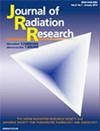Impact of cyclophosphamide on the morphological and histological changes in polyglycolic acid spacers
IF 1.9
4区 医学
Q2 BIOLOGY
引用次数: 0
Abstract
In radiotherapy for pediatric abdominal tumors, determining the effect of concurrent chemotherapy on polyglycolic acid (PGA) spacers is crucial; yet this effect has not been validated. Therefore, we aimed to evaluate the impact of cyclophosphamide (CPA) chemotherapy on the PGA spacer using a rat model. Twenty-four rats were implanted with the spacer, and morphological changes in the spacer were assessed on CT for both the CPA-dosed group (40 mg/kg) and the control group. The size and volume of the spacer were quantified using CT, while the degree of adhesion and microscopic examination of the tissue were determined using pathology specimens. Morphologically, the size of the spacer decreased over time in both the CPA-dosed and control groups, with no significant differences observed between groups. No significant differences in adhesion were observed between the two groups. Macrophages were observed around the PGA fibers, suggesting their involvement in the degradation of the PGA spacer. These results suggest that CPA does not cause significant clinically problematic degradation or adverse tissue reactions to the PGA spacer. This study reinforced the benefits of PGA spacers; however, future research focusing on in vivo longitudinal monitoring of individual rats, as well as on humans, is required.环磷酰胺对聚乙二醇酸垫片形态学和组织学变化的影响
在小儿腹部肿瘤的放射治疗中,确定同期化疗对聚乙二醇酸(PGA)垫片的影响至关重要;但这种影响尚未得到验证。因此,我们以大鼠为模型,评估环磷酰胺(CPA)化疗对 PGA 空间剂的影响。我们为 24 只大鼠植入了垫片,并通过 CT 评估了施用 CPA 组(40 毫克/千克)和对照组垫片的形态变化。利用 CT 对间隔物的大小和体积进行量化,同时利用病理标本确定粘附程度并对组织进行显微镜检查。从形态上看,CPA 剂量组和对照组的间隔物大小均随时间推移而缩小,组间无明显差异。两组在粘附性方面也未发现明显差异。在 PGA 纤维周围观察到巨噬细胞,这表明它们参与了 PGA 间隔物的降解。这些结果表明,CPA 不会导致 PGA 垫片出现明显的临床降解或不良组织反应。这项研究进一步证实了 PGA 垫片的益处;不过,未来的研究还需要侧重于对大鼠个体以及人类进行体内纵向监测。
本文章由计算机程序翻译,如有差异,请以英文原文为准。
求助全文
约1分钟内获得全文
求助全文
来源期刊
CiteScore
3.60
自引率
5.00%
发文量
86
审稿时长
4-8 weeks
期刊介绍:
The Journal of Radiation Research (JRR) is an official journal of The Japanese Radiation Research Society (JRRS), and the Japanese Society for Radiation Oncology (JASTRO).
Since its launch in 1960 as the official journal of the JRRS, the journal has published scientific articles in radiation science in biology, chemistry, physics, epidemiology, and environmental sciences. JRR broadened its scope to include oncology in 2009, when JASTRO partnered with the JRRS to publish the journal.
Articles considered fall into two broad categories:
Oncology & Medicine - including all aspects of research with patients that impacts on the treatment of cancer using radiation. Papers which cover related radiation therapies, radiation dosimetry, and those describing the basis for treatment methods including techniques, are also welcomed. Clinical case reports are not acceptable.
Radiation Research - basic science studies of radiation effects on livings in the area of physics, chemistry, biology, epidemiology and environmental sciences.
Please be advised that JRR does not accept any papers of pure physics or chemistry.
The journal is bimonthly, and is edited and published by the JRR Editorial Committee.

 求助内容:
求助内容: 应助结果提醒方式:
应助结果提醒方式:


